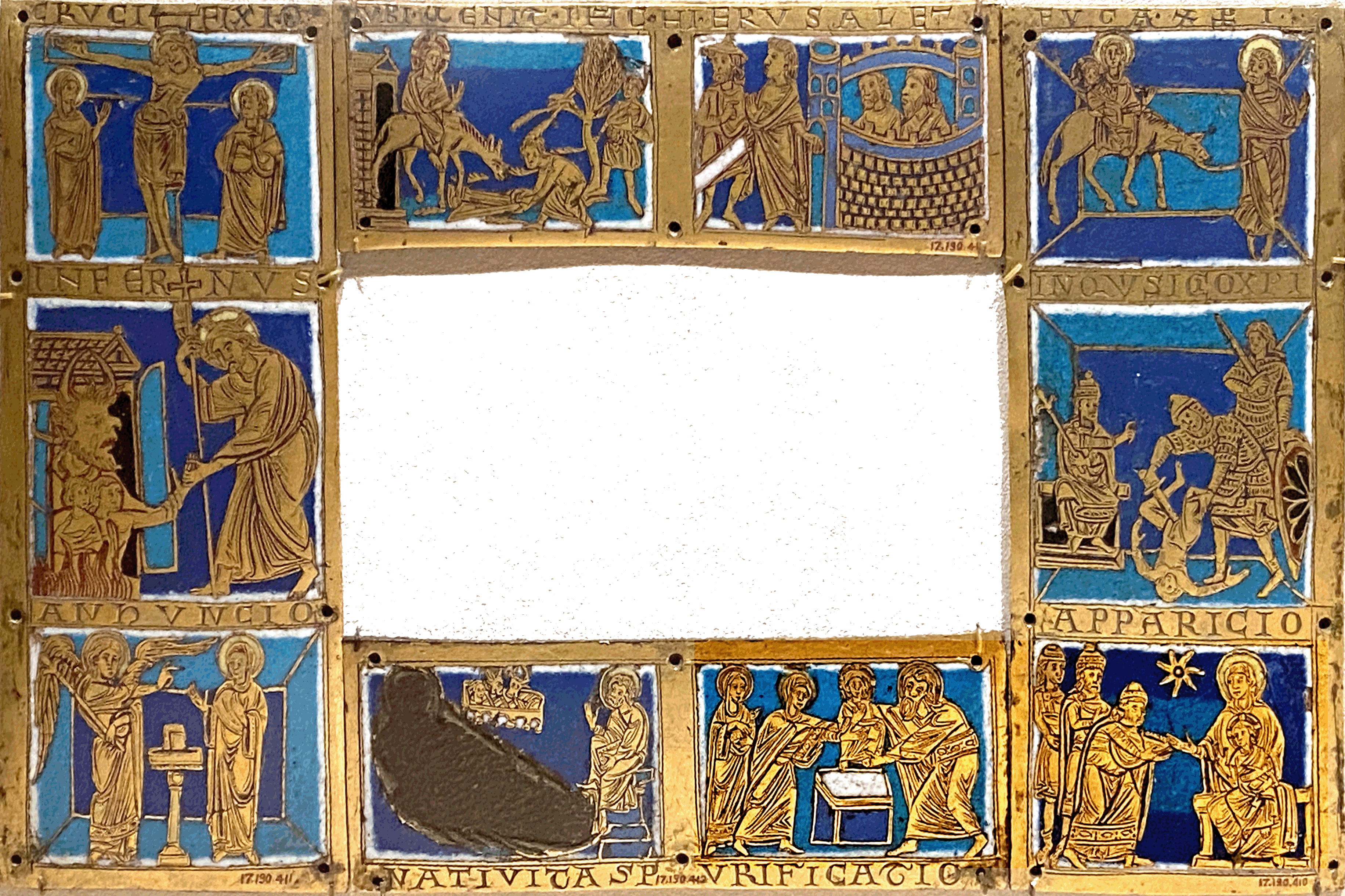The Life of Christ: Plaques from a Portable Altar

Cologne, circa 1160-80
Champlevé enamel on gilded copper
Metropolitan Museum of Art, accession no. 17.190.410-413
The ten panels read counter-clockwise from the bottom left and have inscribed labels as follows:
-
annuncio, The Annunciation:
The angel arranges the fingers of his right hand in the blessing configuration, reflecting Luke 1:28, "blessed art thou among women." The bookstand in the center echoes the shape of the crucifix in the top left panel, giving the Annunciation event a poignancy not felt in most other images of this type. It also functions like the architectural elements in larger versions, separating the figures from each other. In this century books appeared rarely in Annunciation images, mostly in private works such this.
-
nativitas, The birth of Jesus:
This is the earlier format for Nativity images, with Mary recumbent and separate from the baby, who is in a manger with the ox and ass, St. Joseph seated on the right. It is not clear why the image of Mary has been scraped away.
-
purificatio, The Purification (Presentation of Jesus in the Temple):
Mary hands the child to Simeon while Anna stands by on the left.
-
apparicio, The Adoration of the Magi:
The three are depicted as young, middle aged, and old – the three ages expressing universal mankind. As usual, the child is on Mary's lap. The inscription apparicio, "appearance" seems to have been chosen as an equivalent for "epiphany," a word meaning a manifestation of a divine or supernatural being. "Epiphany" is the usual name for the feast celebrated on January 6 in the west commemorating the Magi's visit.
-
inquisicio xpi, The Slaughter of the Innocents:
Soldiers in medieval dress kill the boy children of Bethlehem under the direction of Herod on the left. The inscription ironically labels this "the search for Christ."
-
fuga x Ꝑ i, The Flight into Egypt:
This is a very early attempt at introducing perspective into a picture. Joseph is drawn larger than the other figures and seems to be leading them out into the viewer's own space. In other images of this type, even the technologically accomplished paintings of the Renaissance, the figures are pictured traveling in a straight line toward the left or (usually) right side of the frame.
-
ubi venit ihc hierusalem (double panel): Jesus' Entry into Jerusalem:
The representation of Jerusalem on the right is typical for images of this type. Much less usual is the city represented on the left, which should be Bethany, Jesus' last stop on his way to Jerusalem and the place where he acquired the ass's colt (Mark 11, Luke 19, John 12). It is also the place where he had recently raised Lazarus from the dead. Images of that miracle often have Lazarus emerging from a temple-like structure resembling the one from which Jesus himself emerges in this image.
-
crucifixio, The Crucifixion:
As in most small images of the Crucifixion, the only other figures pictured are Mary and John the Evangelist.
-
infernus, The Anastasis:
This is the usual way that the Resurrection is represented in the East. Christ extends his hand to Adam and Eve, to the dismay of the horned Satan behind them. The door has been opened; in more conventional Anastasis images it has been broken open.
The inscribed word, infernus, means "underworld" or more specifically "Hell."
View this image in full resolution.
Read more about images of Jesus and the Trinity.
Photographed at the site by Richard Stracke, shared under Attribution-NonCommercial-ShareAlike license.
